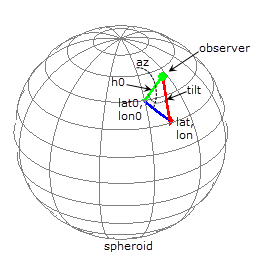lookAtSpheroid
Line of sight intersection with oblate spheroid
Description
[ computes
the latitude and longitude (lat,lon,slantrange]
= lookAtSpheroid(lat0,lon0,h0,az,tilt,spheroid)lat and lon)
of the first point of intersection of the line-of-sight from a viewpoint
in space with the surface of an oblate spheroid. If the line-of-sight
does not intersect with the spheroid, lat and lon contain NaNs.
lat0 and lon0 are
the geodetic coordinates of the viewpoint on the reference spheroid, spheroid. h0 specifies
the geodetic height of the viewpoint in space above the spheroid.
The az and tilt arguments
specify the direction of the view (line-of-sight) as the azimuth angle,
measured clockwise from North, and a tilt angle. The following figure
illustrates these measurements.

The optional slantrange output argument
returns the (3-D Euclidean) distance from the viewpoint to the intersection.
All angles are in degrees.
Examples
Input Arguments
Output Arguments
Version History
Introduced in R2016b